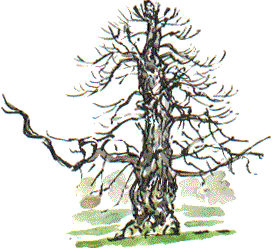Nature Diary Rocks History Gallery Links Home Page  SOME OF THE Sweet Chestnuts of Kensington Gardens remind me of the Gothick costume designs for the current television dramatisation of Mervyn Peake's Gormenghast.
SOME OF THE Sweet Chestnuts of Kensington Gardens remind me of the Gothick costume designs for the current television dramatisation of Mervyn Peake's Gormenghast.
Horse Chestnut now has large sticky buds.
  We take our morning coffee at the cafe at the far end of the lake. I sketch a passing Canada Goose. Like the swans I was watching the other day, these birds can change the proportions of their neck, from short and thick to long and slender. Confusing if you're sketching them.
We take our morning coffee at the cafe at the far end of the lake. I sketch a passing Canada Goose. Like the swans I was watching the other day, these birds can change the proportions of their neck, from short and thick to long and slender. Confusing if you're sketching them.
Matthew Arnold In his Lines written in Kensington Gardens, Matthew Arnold (1822-88) describes a glade in the park that has, in its essentials, scarcely changed (apart from the disappearance of the sheep that grazed here) in over a hundred years. He describes 'the girdling city's hum', years before the arrival of the first car. He mentions pines, elms (sadly wiped out by Dutch Elm disease), chestnuts, a thrush flying over and daisies amongst the grasses.
In his Lines written in Kensington Gardens, Matthew Arnold (1822-88) describes a glade in the park that has, in its essentials, scarcely changed (apart from the disappearance of the sheep that grazed here) in over a hundred years. He describes 'the girdling city's hum', years before the arrival of the first car. He mentions pines, elms (sadly wiped out by Dutch Elm disease), chestnuts, a thrush flying over and daisies amongst the grasses.I'm sure he must have seen the Sweet Chestnut I sketched this morning.
'Calm Soul of all things! make it mine
|

 A Grey Squirrel in the upper branches of a Lime tree nibbles back the thin layer of bark to get at the stringy bast beneath. Bast is the phloem of the tree; the tissues that transport sugars and other foods around the plant. The Vikings used ropes made from lime bast for the rigging of their longships.
A Grey Squirrel in the upper branches of a Lime tree nibbles back the thin layer of bark to get at the stringy bast beneath. Bast is the phloem of the tree; the tissues that transport sugars and other foods around the plant. The Vikings used ropes made from lime bast for the rigging of their longships. The squirrel gathers a good mouthful of the material, tucking in the straggling ends so that it is easier to carry. It comes down the lime tree, crosses the path and climbs up the far side of a large Horse Chestnut. I immediately walk around to see where it is heading but when I get there, a few seconds later, the squirrel is without its bundle, perching on a knobbly lump on the tree. Then it moves its tail and I see a neat nesthole, two or three inches in diameter, and some 15 feet up on the trunk.
The squirrel gathers a good mouthful of the material, tucking in the straggling ends so that it is easier to carry. It comes down the lime tree, crosses the path and climbs up the far side of a large Horse Chestnut. I immediately walk around to see where it is heading but when I get there, a few seconds later, the squirrel is without its bundle, perching on a knobbly lump on the tree. Then it moves its tail and I see a neat nesthole, two or three inches in diameter, and some 15 feet up on the trunk. I've also seen House Sparrows gathering lime bast as nesting material.
I've also seen House Sparrows gathering lime bast as nesting material.